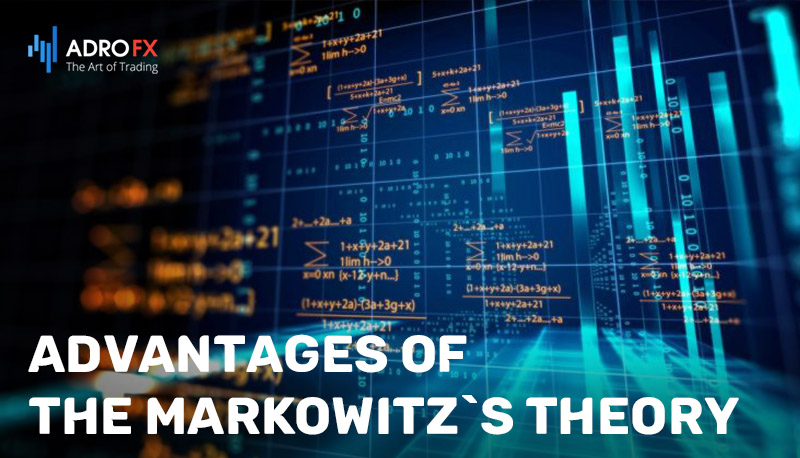Markowitz's Portfolio Theory: Fundamentals and an Example of Calculating Returns

Any investment of funds is accompanied by risks. Their degree is determined by their final income. If it is high, the risks are also high. Investors and traders of the securities market dream about maximum returns with minimal risks. A lot of attention is paid to the ratio of these two parameters.
Outstanding mathematic economists are trying to find the "golden mean". But their calculations lead only to the identification of certain dogmas. For example, choosing the right time to allocate free funds (buy assets) is not key. Almost 90% of income depends on the optimal allocation of funds.
Stock market players create portfolios and buy different securities. They invest in multiple assets, thereby reducing the risk of losing all capital. This principle is described in detail in dozens of portfolio theories. All of them are based on the scientific work of the famous economist Harry Markowitz.
Brief History
Around 1950-1951, Markowitz worked on his doctoral dissertation in economics. In the process of writing his scientific work, he came up with the idea of diversifying (distributing) capital when investing. It formed the basis of Markowitz's future portfolio theory.
In 1952 was published an article by a modest graduate student in "Financial Journal". Its title was "Portfolio Selection". In it, he proposed a mathematical way to form a portfolio.
He outlined certain market conditions, under which his methods would allow for building an optimal portfolio (with maximum return and minimum risks). It should include assets, which weakly correlate with each other (practically have no mutual connection).
The main merit of the graduate student was the following - he proposed to translate the process of selecting an investment portfolio into formal mathematics. He outlined a direct link between the concepts of risk and return.
The economist spent the next 7 years developing and improving his theory. In 1959, he published a monograph. The main points of his article published in 1952 in the Financial Journal were described there. In 1990 Markowitz was awarded the Nobel Prize for Portfolio Investment Theory.
Surprisingly, the scholar was recognized only 40 years after his economic discovery. Many attribute this to the fact that only in the early nineties computers appeared. With their help, they were able to evaluate the effectiveness of the mathematical (probabilistic) approach to forming an optimal portfolio.
How Important Is It to Diversify a Portfolio?

Diversification is the inclusion of different types of assets into an investment portfolio. This approach helps build an optimal structure of assets. It helps to reduce financial risks. Allows increasing income in the short and long term.
By distributing free funds, it is possible to avoid serious financial drawdowns when the value of certain assets in the portfolio falls. For example, the price of a company's shares began to fall. The investor lost capital on this asset but was able to compensate for the loss thanks to growth in the value of other companies stocks.
Experts believe that a portfolio with 8 to 20 financial instruments (assets) can be considered diversified. For example:
- stocks;
- precious metals;
- real estate objects;
- ETF indices.
As you can see, diversification is the most important step in building an optimal portfolio. Markowitz's model relies on it.
The Efficient Frontier – What Is It?
When forming a portfolio, the investor (trader) needs to determine the proportion of different assets (the share of each type of financial instrument). Suppose one has 100% bonds in one's portfolio. If they add stocks, the earnings potential will increase along with the risks. The higher the proportion of equities in the portfolio, the higher the risks. But how to find the "golden mean"? With an efficient frontier.
This is a set of portfolios with optimal proportions of assets that will maximize returns at the lowest possible risks. There are no portfolios that have such a ratio of income to risk, which would bring them above the effective boundary. But some are below it (they are either too risky or do not produce the expected level of return).
Example of Expected Yield Calculation by Markowitz Formula in Excel
According to this theory, an optimal portfolio contains different groups of assets. For example, bonds, futures, stocks, indices, and options. Diversification minimizes risks and reveals negative mutual correlations (correlations). To better understand the above formulas, let's perform a simple calculation.
We have a portfolio of shares of American companies, representing different market segments - Visa, Macy's, AT&T, and Apple.
First action — we need to upload the stock quotes of these companies for the entire previous year to Excel. The second step is to calculate the yield of each asset. This refers to changes in its value over 12 months. Dividends are not considered here.
The asset prices are displayed in a table. Opposite each month line, there is a line with the value. You need to determine the yield for each month using the natural logarithm formula in Excel. For example, in June 2021 the price of the Visa share was 200 dollars, and in July it was 205 dollars. We need to divide the second value by the first - you get 2.5%. This is the yield for July. Other months should be calculated the same way. This also applies to the assets of other companies.
Then you need to calculate the average yield for the year. Add all the percentage returns for each month and divide by 12. Perform this procedure for each asset in the portfolio. For example, the expected return on AT&T stock was negative. You need to remove this asset from the portfolio.
Now you need to determine the risk level of each stock using the Excel functionality. To do this, use the standard deviation formula. Select it in the Excel menu and highlight the column with the prices of the asset for the year. The system will calculate the risk level itself.
The next step is to calculate the covariance of the shares assembled in the portfolio. Excel has a special add-on that will help us at this step. You should open the "Data" tab and select the "Data Analysis" item and find the "Covariance" command in the proposed list. A window will open in which you should specify the cells with the monthly prices of a certain asset and select the grouping by columns.
Once you have determined the expected return on each stock, you can move on to calculating the expected return on the entire portfolio, which consists of these assets. To do this, we need to determine the shares of the three U.S. companies assembled in the portfolio. Recall that we have removed the assets of the fourth company since they have a negative return for the year.
Let us assume that the share of Visa shares in the portfolio is 25%, Macy's shares - 25%, and Apple - 50%. We need to determine the weighted average return on each company's stock. The formula is simple:
(Expected return of Visa * covariance of Visa) + (Expected return of Macy`s * covariance of Macy`s) + (Expected return of Apple * covariance of Apple).
Advantages of the Markowitz`s Theory

This model allows you to take a systematic approach to compile an investment portfolio. Based on simple mathematical formulas and the Excel option, you can calculate the optimal proportion of assets. Other advantages of the method:
- it is not difficult to understand (a novice investor/trader will quickly figure out all the nuances);
- Is suitable for different types of assets - indices, futures, bonds, real estate, derivatives, stocks, options;
- Allows you to determine not the only optimal variant of forming a portfolio, but a lot of variants that will help you to earn the maximum amount at minimal risk;
- Provides stability and structured assets;
- Avoids high risks - financial instruments assembled in a portfolio using the Markowitz method cannot be involved in speculation.
The model of 1959 is still relevant today. True, it is no longer used in its original form. It has been improved and adapted to modern realities.
Disadvantages of the Markowitz`s Theory
The portfolio theory proposed by Markowitz has its disadvantages. Some of them you have probably already guessed when studying the process of calculating the expected return on stocks of American companies. So, the disadvantages of the theory are:
- It is designed for a market in which the quotes of financial instruments are constantly increasing, and there are no tangible fluctuations in the exchange rate. Such processes are characteristic of the economy of the past years. Today the market is more unstable in this respect. Consequently, the asset correlation indicator changes regularly. This does not reduce the risk level of the portfolio;
- Markowitz's model defines the potential return from assets as an arithmetic average. Only the historical quotes of the financial instruments are taken into consideration. It does not take into account numerous macroeconomic factors - inflation, changes in industry prices, the level of GDP, etc. As well as microeconomic factors - financial success, company's business activity, and stock liquidity;
- Risks are determined based on the degree of change in returns relative to the arithmetic average.
Conclusion
Portfolio investments are the most popular and financially beneficial format of investing free funds in assets. The trader's/investor's task comes down to the right choice of financial instruments. They also need to build a proper portfolio structure. It will help to minimize risks and increase earnings potential.
To form the structure of the portfolio, it is necessary to use Markowitz formulas, which were improved by modern economists. The whole process of calculations can be done in Excel. This procedure should be repeated at regular intervals because the market is volatile. The main thing is to know the input data and to understand the results of the calculations correctly.

About AdroFx
Established in 2018, AdroFx is known for its high technology and ability to deliver high-quality brokerage services in more than 200 countries worldwide. AdroFx makes every effort to satisfy its customers and meet all the trading needs of any trader. With the five types of trading accounts, we have all it takes to fit any traders` needs and styles. The company provides access to 115+ trading instruments, including currencies, metals, stocks, and cryptocurrencies, which make it possible to make the most out of trading on the financial markets. Considering all the above, AdroFx is the perfect variant for anyone who doesn't settle for less than the best.









